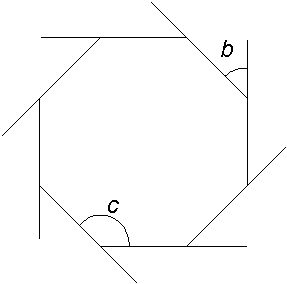Angles of an octagon

|
|
Y11 (05/2000) |
||
|
a) |
|
360 |
moderate |
|
b) |
i) |
45 [Accept answer to a) ÷ 8]. • 360º ÷ 8 [Accept answer to a) ÷ 8]. |
easy |
|
c) |
i) |
135 [Accept 180 - answer to b) i)]. • 180º - 45º. |
easy |
| Shape | Sides | Sum of interior angles |
| Triangle | 3 | 180° |
| Quadrilateral | 4 | 360° |
| Pentagon | 5 | 540° |
| Hexagon | 6 | 720° |
| Octagon | 8 | 1080° |
|
|
Common error |
Likely calculation |
Likely reason |
|
a) |
1080 |
(8 - 2) × 180 |
Confuses interior and exterior angle. |

